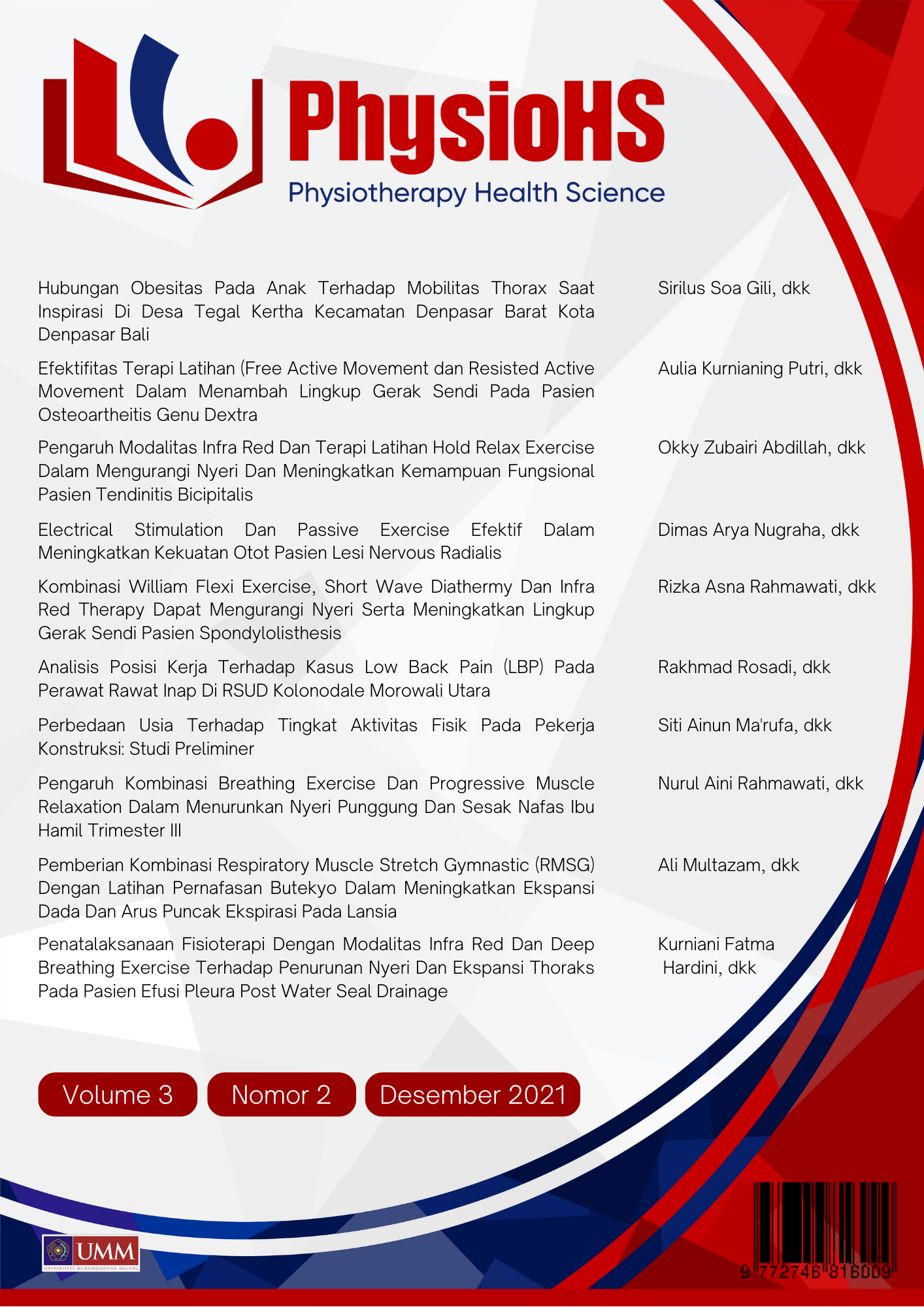Penatalaksanaan Fisioterapi dengan Modalitas Infrared dan Deep Breathing Exercise terhadap Penurunan Nyeri dan Ekspansi Thoraks pada Pasien Efusi Pleura Post Water Seal Drainage
DOI:
https://doi.org/10.22219/physiohs.v3i2.19466Keywords:
Infrared, Deep breathing exercise, nyeri, ekspansi thoraksAbstract
Semakin banyak masyrakat dari usia muda hingga tua yang menjadi perokok aktif, serta pencemaran udara didalam ataupun diluar ruangan tempat kerja merupakan faktor salah satu penyebab terjadinya gangguan paru salah satunya efusi pleura. Efusi pleura merupakan penyakit yang dapat timbul dari penyakit primer seperti gagal jantung kongestif, sirosis hari dan sindrom nefrotik dengan keadaan meningkatnya cairan didalam cavum pleura, sehingga diberikan tindakan pemasangan water seal drainage (WSD) untuk mempertahankan tekanan udara dalam paru agar dapat normal. Efusi pleura post WSD menyebabkan gangguan berupa sesak napas, terjadinya perubahan pola nafas dan perubahan postur tubuh. Tujuan penelitian ini untuk mengetahui penatalaksanaan fisioterapi dengan infrared dan deep breathing exercise terhadap expansi thoraks pada penderita efusi pleura post WSD. Metode penelitian ini menggunakan studi kasus pada penderita efusi pleura post WSD rawat inap di RS Umum Dungus Madiun dengan frekuensi terapi Infrared 4x dan deep breathing exercise dengan 8x selama 9 hari. Nyeri diukur dengan menggunakan VAS dan Ekspansi thoraks diukur dengan menggunakan pita ukur. Hasil penelitian didapatkan bahwa infrared dan deep breathing exercise dapat menurunkan nyeri dan meningkatkan ekspansi thoraks pada penderita efusi pleura post WSD.
Downloads
References
Adam Malik Medan. Medan: Jurnal AnLabMed Analis Laboratorium Medis, 1(1), 23-32.
Dewi, P. B. D. T. 2011. Efusi Pleura Masif: Sebuah Laporan Kasus. Bali
Dural, Rajarman, et al. 2010. Managing a Chest Tube and Drainage System . AORN Journal.
Gunjal, S. B., Shinde, N. K., Kazi, A. H., & Mahajan, A. A. 2015. Effectiveness of deep breathing versus segmental breathing exercises on chest expansion in pleural effusion. International Journal of Health Sciences and Research, 5(7), 234-40.
Kisner, Carollyn and Lynn Allen Colby. 2007. Therapeutic Exercise Foundation and Technique. Edisi 5. Philadelphia: F.A. Davis Company.
Luklunaningsih, Zuyina. 2020. Pengaruh Infra Red dengan Massage Fisioterapi terhadap Tingkat Stress Mahasiswa yang Sedang Mengerjakan Tugas Akhir. Jurnal Ilmiah Kesehatan, Vol 15(3) hlm 167-176.
Nasution, S. A. 2019. Skrining Makroskopis Cairan Pleura Dari Efusi Pleura Di Unit Laboratorium Patologi Anatomi Rumah Sakit Umum Pendidikan Haji
Nirmalasari, Novita., Mardiyono, Edi Dharmana, Thohar Arifin. 2020. Deep Breathing Exercise and Active Range of Motion Influence Physiological Response of Congestive Heart failure Patients. Nurse Media Jurnal of Nursing, Vol 10(1) hlm 57-65.
Pryor J., Prasad S. (2008). Physiotherapy for Respiratory and Cardiac Problems Adults and Paediatrics, 4th Edition. London: Churchill Livingstone
Putra, Yudha Wahyu. 2013. Efektifitas Jarak Infra Merah Terhadap Ambang Nyeri Surakarta.
Reddy R, et al. (2019). Reliability of Chest Wall Mobility and Its Correlation With Lung Functions In Healthy Nonsmokers, Healthy Smokers, And Patient With COPD. Canadian Respiratory Journal, 2019, 1-11. https://doi.org/10.1155/2019/5175949
Salawati, Liza. 2016. Hubungan Merokok dengan Derajat Penyakit Paru Obstruksi Kronik. Aceh: Jurnal Kedokteran Syiah Kuala
Sultanpuram, Sagarika., G.K. Alaparthi, S.K. Krishnakumar, Z.C.P. Ottayil. 2016. Physiotherapy Practice Patterns for Management of Patients Undergoing Thoracic Surgeries in India: A Survey. Surgery Research and Practice. India
Widowati, R., Murti, B., & Pamungkasari, E. P. 2017. Effectiveness of acupuncture and infrared therapies for reducing musculoskeletal pain in the elderly. Solo: Indonesian Journal of Medicine, 2(1), 41-51.
Downloads
Published
How to Cite
Issue
Section
License
Copyright (c) 2021 Physiotherapy Health Science (PhysioHS)

This work is licensed under a Creative Commons Attribution-ShareAlike 4.0 International License.
Authors who publish with Physiotherapy Health Science (PhysioHS) agree to the following terms:
- For all articles published in Physiotherapy Health Science (PhysioHS), copyright is retained by the authors. Authors give permission to the publisher to announce the work with conditions. When the manuscript is accepted for publication, the authors agree to automatic transfer of the publishing right to the publisher.
- Authors retain copyright and grant the journal right of first publication with the work simultaneously licensed under a Creative Commons Attribution-ShareAlike 4.0 International License that allows others to share the work with an acknowledgement of the work's authorship and initial publication in this journal.
- Authors are able to enter into separate, additional contractual arrangements for the non-exclusive distribution of the journal's published version of the work (e.g., post it to an institutional repository or publish it in a book), with an acknowledgement of its initial publication in this journal.
- Authors are permitted and encouraged to post their work online (e.g., in institutional repositories or on their website) prior to and during the submission process, as it can lead to productive exchanges, as well as earlier and greater citation of published work (See The Effect of Open Access).
This work is licensed under a Creative Commons Attribution-ShareAlike 4.0 International License.





















